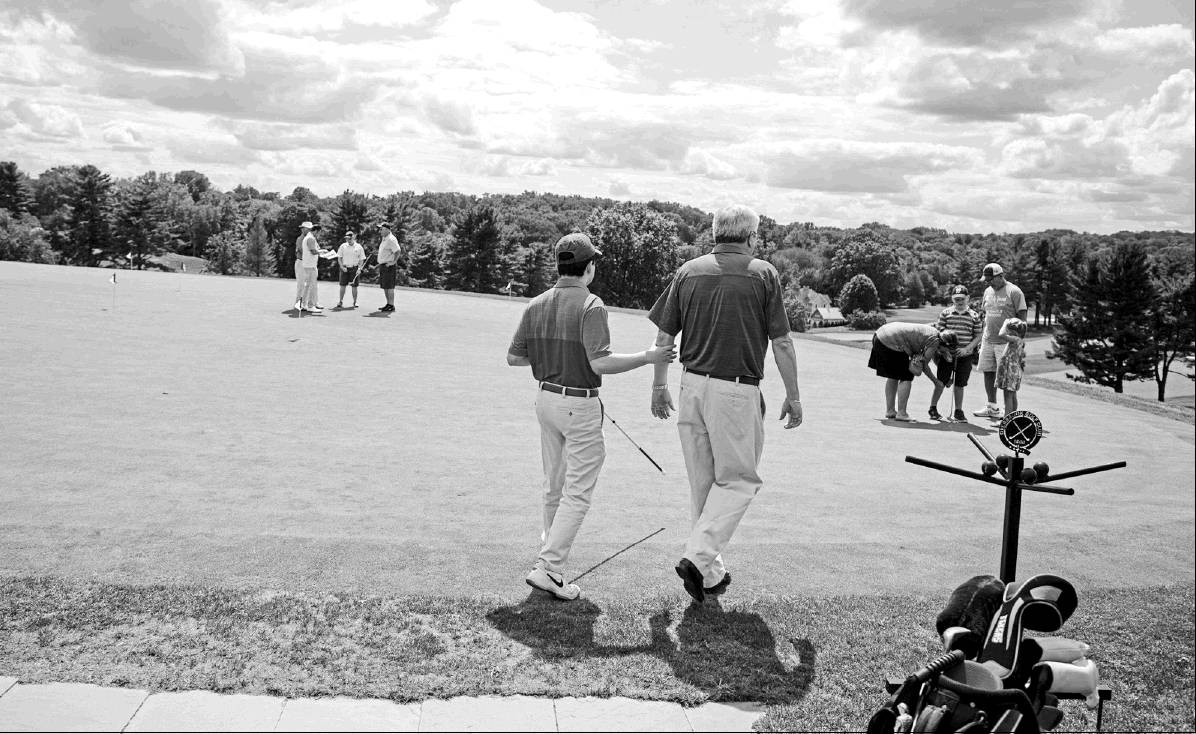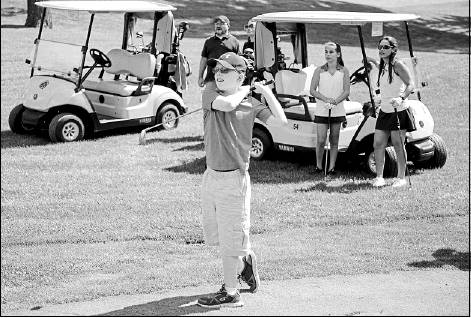THE UP LIFT
Giving it their best shot
With help from coaches, visually impaired golfers score success on the links.
By Natalie Pompilio FOR THE INQUIRER
More than a decade ago, Dave Zimmaro was working at a golf club during college when one of the club’s certified PGA instructors casually mentioned that his next student was blind and that they’d connected through the Junior Blind Golf Association (JBGA).
“I was, ‘Stop — are you kidding me? Blind people can’t play golf. C’mon,’ ” recalled Zimmaro, 33, now the youth golf director at Villanova’s Overbrook Golf Club. “I thought it was all an elaborate joke.”
Then Zimmaro saw teenager Patrick Molloy, blind since birth, send a drive soaring with a left-handed swing so smooth that it had once been compared to World Golf Hall of Famer Phil Mickelson’s.
“He hit it and I said, ‘No way,’ ” Zimmaro said. “I didn’t know what this [organization] was, but I wanted to be a part of it.” That’s how Zimmaro became a coach for the JBGA, which partners blind or visually impaired young people with a PGA teacher for regular lessons. The nonprofit provides all of the necessary equipment for free — including the golf clubs — to participants, who are ages 7 to 21 and live in the tristate area. The lessons are provided at a golf course close to the participants’ homes.
On this sunny September Saturday, Zimmaro was hosting JBGA players and coaches at Overbrook, putting them into foursomes with sighted students from his youth program. Each young player had a parent along to play or to cheer.
“To watch these kids play and see the way they love it is a revelation,” said Norman Kritz, who cofounded the JBGA in 1993, was its longtime program director, and who, at age 90, is still committed to the cause. “We’ve had so many kids involved, about 75 right now, and it’s very gratifying. It’s important that parents of physically challenged kids know there’s something out there for them.”
The day before the event, Zimmaro had surprised his sighted golf students by declaring it “Overcoming Adversity Day.” He challenged them to take a shot with their eyes closed, then while sitting in a wheelchair, and then as if they were missing a limb. He also put obstacles in their way on the course, like forcing them to play balls that had landed in a sand trap or rough terrain.
Ali Gildea, 13, said most of the students “whiffed it” when they took a swing without sight.
“I had one decent shot, but most of my shots were pretty bad,” she said. “It was hard.”
That was the point Zimmaro wanted to drive home for his students.
“They gain perspective, and it builds toughness, perseverance,” he said. “I put pictures of students [with different physical challenges] at each [tee], and some of the kids were in tears, like, ‘How do they do that?’ They had no awareness that something like this even exists.”
Mike Molloy, Patrick’s father and current JBGA program director, organizes at least one group outing per month. This was a return trip to Overbrook, a pristine course with rolling green hills.
New JBGA students start with small swings. Some coaches will put a metronome behind a hole so the player can hit toward the sound.
“It’s all about building that muscle memory,” Mike Molloy said. “I don’t think Patrick took a full swing for months.”
Patrick Molloy, now 26, began taking lessons with a JBGA volunteer coach when he was 8 and continued to play golf through college. He said it’s the perfect sport for a blind person.
“As long as you have a coach who’s lined you up properly and taught you how to swing, you’re always going to find the ball,” he said. “You don’t have to see the ball in order to hit it. In fact, that’s a mistake that sighted golfers make: They’ll hit their shot and then lift their heads to watch that beautiful drive soar 300-plus yards down the fairway — but as soon as you lift your head, you lift your body and mess up the shot.
“As a blind golfer, you keep your head down, swing through and your coach tells you exactly where your ball went.”
Paris Sterrett, a coach for the JBGA and for adult members of the Middle Atlantic Blind Golf Association, agreed, adding that “70% of being successful in golf is how you line up, and you have to line up whether you’re blind or not.
“Your alignment, your stance is so important. Where you put your feet, where you place the ball,” said Sterrett, 77, who also coaches junior varsity golf at Episcopal Academy. “If you’re off just a little bit, that can affect the whole shot.”
Sterrett has coached golfers of all ages. There was the 5-year-old who slept with the trophy he’d won, and the 8-year-old who gave Sterrett a big hug after his first lesson. There were the ORFs (Old Retired Farts — like Sterrett) and octogenarians, like the 89-year-old who hit his first and only hole-inone on a par-three hole that was 120 yards away, open on the front and with a ravine on the left.
“I lined him up, and he took a swing,” Sterrett said of that momentous shot in 2003. “He’d been playing golf for 65 years. It made national news.”
On this recent Saturday, Sterrett was coaching Leah Mullaly, 27, a legally blind golfer with whom he’s worked since she was
9. Mike Sullivan and his 9-yearold son, Jack, both of Wayne, rounded out the foursome. It was Mullaly’s turn to take a shot.
“We’re going to walk off the putt,” Sterrett said as he and Mullaly, who was holding his elbow, walked and counted the paces between the cup and Mullaly’s ball.
“I get 27 feet and it’s uphill,” he told her. “Jack says it’s going to break right to left — Jack knows these things.”
Sterrett helped Mullaly find her stance. She swung, sending the ball to the left of the hole.
“Nice swing,” Jack said.
Mullaly smiled.
“I don’t think Jack really knows that I can’t see that well,” she later said of her young fellow golfer. “He doesn’t know that I don’t know where the ball goes.”
The foursome playing in front of Mullaly’s group included Ali Gildea and her mom, Mary, club members from Bryn Mawr, and Tim Hengst, 13, and his dad, Sean, from Gloucester Township, N.J. Ali and Tim connected immediately over how they’d soon start eighth grade. Strangers when the game began, the players were each other’s biggest cheerleaders by the second hole.
Tim, who is legally blind, is a very enthusiastic golfer and is even teaching his father to play.
The weak point in his dad’s game? His form.
“He loses his balance a lot,” Tim said. “It’s hilarious.”
His father agreed. “It’s true. I’m terrible. When I swing I do this weird step thing,” he said. “Tim sets me straight, and when I listen to him, I get better.”
The Gildeas and the Hengsts won the four-hole “scramble” game. Tim took his trophy to a family party later that day.
But winning wasn’t the best part of the day.
“The trophy was nice, but he really had a fun time playing with Mary and Ali,” Sean Hengst said. “Before we even got the trophy, he told me what a good time he’d had and how he’d felt like part of a team.”



